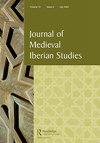“If you want to pray to Mercury, wear the garments of a scribe:” kuttāb, udabāʾ, and readers of the Ghāyat al-Ḥakīm in the court of ʿAbd al-Raḥmān III
IF 0.4
2区 历史学
0 MEDIEVAL & RENAISSANCE STUDIES
引用次数: 0
Abstract
ABSTRACT This work addresses the question of the intended audience of the Ghāyat al-Ḥakīm, the famous Andalusi treatise on magic, better known by its Latin moniker, Picatrix. I propose that a substantial portion of the Ghāya's readers were scribes, or kuttāb, in the tenth-century caliphate of Cordova. Many of these scribes were considered udabāʾ; that is, those who possessed adab, an elusive yet ubiquitous term in Islamic culture. The concept of adab, scribal culture, and magic traveled to al-Andalus in similar ways and at similar times, and they reached their apex in two figures: Ibn Rabbih and al-Qurṭubī. I argue that, in the Ghāya's spells and rituals, these kuttāb and udabāʾ could find not only a shortcut to acquire abilities vital to their work but also more dubious ways to promote themselves in a difficult political environment. Further, I show that sections of the Ghāya potentially allowed these officials to establish contact with the “supreme scribe,” the personified planet Mercury, who is closely related to the mythical sage Hermes Trismegistus."如果你想向墨丘利祈祷,就穿抄写员的衣服" kuttāb, udababal - - - - - - -以及在阿卜杜勒al-Raḥmān III庭上Ghāyat al- -Ḥakīm的读者
本文探讨了安达卢西著名的魔法专著《Ghāyat al-Ḥakīm》的目标读者,该书以其拉丁文绰号Picatrix更为人所知。我认为Ghāya的读者中有相当一部分是文士,或者kuttāb,在10世纪的科尔多瓦哈里发国。这些抄写员中有许多被认为是乌达布哈;也就是说,那些拥有adab的人,这是一个难以捉摸但在伊斯兰文化中无处不在的术语。阿达布、抄写文化和魔法的概念以类似的方式和时间传播到安达卢斯,并以两个人的形象达到了顶峰:伊本·拉比和al-Qurṭubī。我认为,在Ghāya的咒语和仪式中,这些kuttāb和udabahu不仅可以找到获得对他们的工作至关重要的能力的捷径,而且还可以找到在艰难的政治环境中提升自己的更可疑的方式。此外,我展示了Ghāya的部分可能允许这些官员与“最高抄写员”建立联系,拟人化的水星行星,与神话中的圣人赫尔墨斯Trismegistus密切相关。
本文章由计算机程序翻译,如有差异,请以英文原文为准。
求助全文
约1分钟内获得全文
求助全文
来源期刊

Journal of Medieval Iberian Studies
MEDIEVAL & RENAISSANCE STUDIES-
CiteScore
1.20
自引率
20.00%
发文量
24
 求助内容:
求助内容: 应助结果提醒方式:
应助结果提醒方式:


